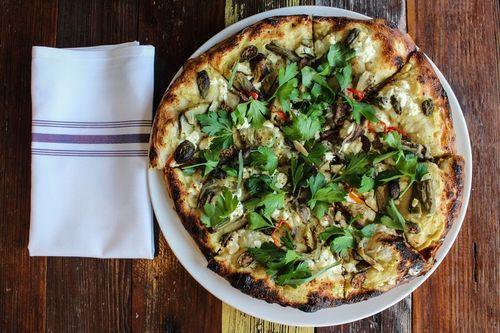Alia Akkam, photo by Andrea Weir
Serious about crafting restaurant-caliber pizza on your
home turf? Then you’ve probably already shunned the packaged shredded
mozz for creamy balls of the fresh stuff. But that’s just the first step
to a killer pie. Ensuring your pizza emerges from the oven with the
vibrant sauce, airy but charred crust, and brilliantly creative toppings
of the latest pizzerias is a lot harder than it looks. Fortunately, we
tapped the pizza experts (aka pizzaioli) from some of the newest pizza
destinations across the country for their expert advice.
Strategy #1: Go Thick, Go Low
At Marta, Danny Meyer’s latest New York project, inside the Martha Washington Hotel, Nick Anderer mans the wood-burning ovens that elicit paper thin, Roman-style pizzas. This technique is even more challenging to master in the civilian kitchen devoid of 600-degree ovens, but the ambitious should certainly try. “If the raw dough is too dry, it burns before getting crispy. Higher hydration allows for more time on the pizza stone without burning, and this extra time results in crispier crust,” he explains. “But the bitch of it is that working with high-hydration dough at home is tricky, usually because of the transfer to the oven.”
Instead, Anderer points out, consider the pan pizza, or thicker, focaccia-like pizza rustica: “You can cook it for a longer time, at a lower temperature—closer to 450 or 500 degrees. It won’t be like pizzeria pizza, but it will be crispy and delicious, albeit a touch thicker and doughier.” Just roll out the dough about twice as thick as usual, then bake in a well-oiled rimmed baking sheet instead of on a pizza peel.
Strategy #2: Let the Tomato Do the Work
Lacing the fresh tomato sauce that will cloak your pizza with the likes of oregano and garlic powder is natural incentive for the eager home cook. Jason Magee, general manager of Pellicola, in Los Angeles, advises you to stop tinkering with the spice rack, however. “If you try to create a dough, sauce or cheese by itself, it doesn’t mean all the ingredients will make for the best pizza when combined. Sometimes your dough will be more salty, and you want to complement that with sweet tomato sauce,” he says.
San Marzano is the tomato of choice at Pellicola, and Magee says its unadulterated state is the pizzeria’s biggest secret. “A lot of people season their sauces and get carried away. They lose the actual taste of the tomato,” he points out. “Let it stand for itself.” Just snag a can of whole San Marzanos, roughly squeeze them over a bowl to pulverize, then scatter over your dough.
Strategy #3: Go Beyond Pepperoni
Spontaneous, late-night delivery may propel you to order a pizza clustered with myriad toppings, but Ryan Pera, chef at Coltivare, in Houston, thinks less is more. “Don’t put too many in the center,” he warns. “We leave the very center topping-less so that when the slices are cut, the toppings don’t fall off.”
At Coltivare, Pera is often found dressing up pies with unconventional meats such as pork confit and braised duck (or even shrimp, as above). So you don’t fall victim to shrink-wrapped spheres of pepperoni, Pera suggests giving your pizza a quality carnivorous boost by venturing to a specialty market for, say, Italian-style salami. After pulling the pie out of the oven, Pera encourages a final touch of balsamic vinegar or freshly grated Parmesan “to brighten the flavor and add a bit of texture.” He’s a fan of meat-free pizzas, too; just swap tomato sauce for vibrant purees of poached garlic or butternut squash.
Strategy #4: Master the Stone
A pizza stone, you may already
know, is essential to stellar crust. This concentrated heat source
rapidly induces caramelization. But how do you get the most from it?
Bobby Hellen, chef at GG’s, in New York, says to always embrace the
16-inch stone, because its larger surface leads to consistent cooking,
no matter the size. “It should go in at 425 degrees for 15 minutes.
Perfect pizza temperature is as high as possible, without immediate
burn,” Hellen explains. “Never bake pizza on a cold stone because it
will create the wrong type of steam and come out soggy.”
After about 8 to 10 minutes,
start peering into the oven—don’t open the door—and hope for “brown and
crispy edges, not black with carbon.” Stone savvy will be moot, however,
if you don’t properly proof your dough in advance; the mound has to sit
in the refrigerator for 24 hours before handling, otherwise “it won’t
cook uniformly, and you won’t get that lift in the finished crust that
you want,” Hellen notes. “And it will give you a stomach ache.”
Strategy #5: Give Your Pizza the Farmer’s Market Treatment
Some pies sit behind pizzeria
glass, congealed and unappetizing. You want yours to burst with vivid
flavor. Colin Beauvais, of Parlor Pizza Bar, in Chicago, recommends
perusing the farmer’s market for the five freshest ingredients. “Don’t
come home with anything outside of them, and think about those items
carefully. For example, if using pancetta, I would suggest something
acidic, like a lemon wheel or stewed collard greens, that would pair
well with the meat,” he says.
Beauvais’ favorite
straight-from-the farm toppings? Root vegetables like kohlrabi. “The
Midwest grows them well,” he says, “and they are understated and not
used very often.” Just be sure to roast them before using them to top
your pizza.
Source : Yahoo Food by Epicurious.com - Fri, 12 Sep, 2014.


No comments:
Post a Comment
Any comments send to my e-mail : indonesiabiznet@gmail.com